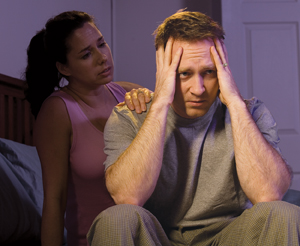Understanding Post-Traumatic Stress Disorder (PTSD)
Understanding Post-Traumatic Stress Disorder (PTSD)
You may have post-traumatic stress disorder (PTSD) if you’ve been through a traumatic event and are having trouble dealing with it. Such events may include a car crash, rape, domestic violence, military combat, or violent crime. While it is normal to have some anxiety after such an event, it usually goes away in time. But with PTSD, the anxiety is more intense and keeps coming back. And the trauma is relived through nightmares, intrusive memories, and flashbacks (vivid memories that seem real). The symptoms of PTSD can cause problems with relationships and make it hard to cope with daily life. But it can be treated. With help, you can feel better.
How does it feel?
Symptoms of PTSD often start within a few months of the event. Here are some common symptoms:
You startle more easily, and feel anxious and on edge all the time. This can lead to sleep problems. It a can cause you to feel overwhelmed or become angry or upset more easily. Panic attacks (sudden, intense feelings of terror and a strong need to escape from wherever you are) can also occur.
You relive the event through nightmares and flashbacks. During these, you may feel strong emotions and as though you’re reliving the event all over again.
You avoid people, places, or activities that remind you of the trauma. You may hold in your feelings and become emotionally numb. It may be hard to concentrate at work or school or to relax with friends. You may be afraid to let people get close to you.
Who does it affect?
Not everyone who survives a trauma will have PTSD. But many will. In fact, millions of people have the condition. PTSD can happen to anyone, but it most often develops after a person feels his or her or another’s life is threatened.
You’re at risk for PTSD if you have experienced or witnessed:
A rape or sexual abuse
A mugging or carjacking
A car accident or plane crash
A life-threatening illness
War
Domestic violence
Childhood abuse
Natural disasters such as earthquakes, floods, or hurricanes
The sudden death of a loved one
Finding help
The first step is to talk to a trusted counselor or healthcare provider. He or she can help you take the next step to treatment. This may involve therapy (also called counseling) and medication.
Are you having suicidal thoughts?
You may be feeling helpless, hopeless, and that you can’t go on. You may even have thoughts of suicide. But help is available. There are ways to ease this pain and manage the problems in your life.
If you are thinking about harming or killing yourself, please tell your healthcare provider or someone you care about immediately or go to the nearest crisis walk-in center or emergency room.
You can also call, toll-free,
800-SUICIDE (800-784-2433)
800-273-TALK (800-273-8255)
Resources
American Psychiatric Association
888-357-7924
www.healthyminds.orgAmerican Psychological Association
www.apa.org/helpcenterAnxiety and Depression Association of America
www.adaa.orgMental Health America
www.nmha.orgNational Center for PTSD
www.ptsd.va.govNational Institute of Mental Health
www.nimh.nih.gov/topics/topic-page-ptsd.shtmlNational Suicide Prevention Lifeline
800-273-8255 (800-273-TALK)
www.suicidepreventionlifeline.org
Updated:
October 17, 2017
Sources:
Posttraumatic stress disorder in adults: Epidemiology, pathogenesis, clinical manifestations, course, assessment, and diagnosis, Up To Date
Reviewed By:
Ballas, Paul, DO,Fraser, Marianne, MSN, RN
